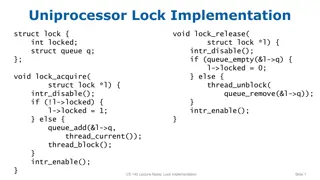
Optimizing Lock-Based Concurrent Data Structures in Operating Systems
"Learn how adding locks to data structures ensures thread safety and explore examples of concurrent counters with and without locks. Understand the impact of lock placement on correctness and performance in operating systems."
Download Presentation

Please find below an Image/Link to download the presentation.
The content on the website is provided AS IS for your information and personal use only. It may not be sold, licensed, or shared on other websites without obtaining consent from the author. If you encounter any issues during the download, it is possible that the publisher has removed the file from their server.
You are allowed to download the files provided on this website for personal or commercial use, subject to the condition that they are used lawfully. All files are the property of their respective owners.
The content on the website is provided AS IS for your information and personal use only. It may not be sold, licensed, or shared on other websites without obtaining consent from the author.
E N D
Presentation Transcript
29. Lock-based Concurrent Data Structures Operating System: Three Easy Pieces 1 Youjip Won
Lock-based Concurrent Data structure Adding locks to a data structure makes the structure thread safe. How locks are added determine both the correctness and performance of the data structure. 2 Youjip Won
Example: Concurrent Counters without Locks Simple but not scalable 1 2 3 4 5 6 7 8 9 10 11 12 13 14 15 16 17 18 19 typedef struct __counter_t { int value; } counter_t; void init(counter_t *c) { c->value = 0; } void increment(counter_t *c) { c->value++; } void decrement(counter_t *c) { c->value--; } int get(counter_t *c) { return c->value; } 3 Youjip Won
Example: Concurrent Counters with Locks Add a single lock. The lock is acquired when calling a routine that manipulates the data structure. 1 2 3 4 5 6 7 8 9 10 11 12 13 14 15 16 typedef struct __counter_t { int value; pthread_lock_t lock; } counter_t; void init(counter_t *c) { c->value = 0; Pthread_mutex_init(&c->lock, NULL); } void increment(counter_t *c) { Pthread_mutex_lock(&c->lock); c->value++; Pthread_mutex_unlock(&c->lock); } 4 Youjip Won
Example: Concurrent Counters with Locks (Cont.) (Cont.) 17 18 19 20 21 22 23 24 25 26 27 28 void decrement(counter_t *c) { Pthread_mutex_lock(&c->lock); c->value--; Pthread_mutex_unlock(&c->lock); } int get(counter_t *c) { Pthread_mutex_lock(&c->lock); int rc = c->value; Pthread_mutex_unlock(&c->lock); return rc; } 5 Youjip Won
The performance costs of the simple approach Each thread updates a single shared counter. Each thread updates the counter one million times. iMac with four Intel 2.7GHz i5 CPUs. Performance of Traditional vs. Sloppy Counters (Threshold of Sloppy, S, is set to 1024) Synchronized counter scales poorly. 6 Youjip Won
Perfect Scaling Even though more work is done, it is done in parallel. The time taken to complete the task is not increased. 7 Youjip Won
Sloppy counter The sloppy counter works by representing A single logical counter via numerous local physical counters, on per CPU core A single global counter There are locks: One fore each local counter and one for the global counter Example: on a machine with four CPUs Four local counters One global counter 8 Youjip Won
The basic idea of sloppy counting When a thread running on a core wishes to increment the counter. It increment its local counter. Each CPU has its own local counter: Threads across CPUs can update local counters without contention. Thus counter updates are scalable. The local values are periodically transferred to the global counter. Acquire the global lock Increment it by the local counter s value The local counter is then reset to zero. 9 Youjip Won
The basic idea of sloppy counting (Cont.) How often the local-to-global transfer occurs is determined by a threshold, S (sloppiness). The smaller S: The more the counter behaves like the non-scalable counter. The bigger S: The more scalable the counter. The further off the global value might be from the actual count. 10 Youjip Won
Sloppy counter example Tracing the Sloppy Counters The threshold S is set to 5. There are threads on each of four CPUs Each thread updates their local counters ?1 ?4. Time 0 1 2 3 4 5 6 7 G 0 0 0 0 0 0 ?? 0 0 1 2 3 4 ?? 0 0 0 0 0 1 1 2 ?? 0 1 2 3 3 3 3 4 ?? 0 1 1 1 2 3 4 5 0 0 5 (from ?1) 10 (from ?4) 5 0 11 Youjip Won
Importance of the threshold value S Each four threads increments a counter 1 million times on four CPUs. Low S Performance is poor, The global count is always quire accurate. High S Performance is excellent, The global count lags. Scaling Sloppy Counters 12 Youjip Won
Sloppy Counter Implementation 1 2 3 4 5 6 7 8 9 10 11 12 13 14 15 16 17 18 19 20 21 22 23 typedef struct __counter_t { int global; pthread_mutex_t glock; // global lock int local[NUMCPUS]; pthread_mutex_t llock[NUMCPUS]; // ... and locks int threshold; } counter_t; // global count // local count (per cpu) // update frequency // init: record threshold, init locks, init values // of all local counts and global count void init(counter_t *c, int threshold) { c->thres hold = threshold; c->global = 0; pthread_mutex_init(&c->glock, NULL); int i; for (i = 0; i < NUMCPUS; i++) { c->local[i] = 0; pthread_mutex_init(&c->llock[i], NULL); } } 13 Youjip Won
Sloppy Counter Implementation (Cont.) (Cont.) 24 // update: usually, just grab local lock and update local amount 25 // once local count has risen by threshold , grab global 26 // lock and transfer local values to it 27 void update(counter_t *c, int threadID, int amt) { 28 pthread_mutex_lock(&c->llock[threadID]); 29 c->local[threadID] += amt; 30 if (c->local[threadID] >= c->threshold) { // transfer to global 31 pthread_mutex_lock(&c->glock); 32 c->global += c->local[threadID]; 33 pthread_mutex_unlock(&c->glock); 34 c->local[threadID] = 0; 35 } 36 pthread_mutex_unlock(&c->llock[threadID]); 37 } 38 39 // get: just return global amount (which may not be perfect) 40 int get(counter_t *c) { 41 pthread_mutex_lock(&c->glock); 42 int val = c->global; 43 pthread_mutex_unlock(&c->glock); 44 return val; // only approximate! 45 } // assumes amt > 0 14 Youjip Won
Concurrent Linked Lists 1 2 3 4 5 6 7 8 9 10 11 12 13 14 15 16 17 (Cont.) // basic node structure typedef struct __node_t { int key; struct __node_t *next; } node_t; // basic list structure (one used per list) typedef struct __list_t { node_t *head; pthread_mutex_t lock; } list_t; void List_Init(list_t *L) { L->head = NULL; pthread_mutex_init(&L->lock, NULL); } 15 Youjip Won
Concurrent Linked Lists (Cont.) 18 19 20 21 22 23 24 26 27 28 29 30 31 (Cont.) int List_Insert(list_t *L, int key) { pthread_mutex_lock(&L->lock); node_t *new = malloc(sizeof(node_t)); if (new == NULL) { perror("malloc"); pthread_mutex_unlock(&L->lock); return -1; // fail new->key = key; new->next = L->head; L->head = new; pthread_mutex_unlock(&L->lock); return 0; // success } 16 Youjip Won
Concurrent Linked Lists (Cont.) (Cont.) 32 32 33 34 35 36 37 38 39 40 41 42 43 44 int List_Lookup(list_t *L, int key) { pthread_mutex_lock(&L->lock); node_t *curr = L->head; while (curr) { if (curr->key == key) { pthread_mutex_unlock(&L->lock); return 0; // success } curr = curr->next; } pthread_mutex_unlock(&L->lock); return -1; // failure } 17 Youjip Won
Concurrent Linked Lists (Cont.) The code acquires a lock in the insert routine upon entry. The code releases the lock upon exit. If malloc() happens to fail, the code must also release the lock before failing the insert. This kind of exceptional control flow has been shown to be quite error prone. Solution: The lock and release only surround the actual critical section in the insert code 18 Youjip Won
Concurrent Linked List: Rewritten 1 2 3 4 5 6 7 8 9 10 11 12 13 14 15 16 17 18 19 20 21 void List_Init(list_t *L) { L->head = NULL; pthread_mutex_init(&L->lock, NULL); } void List_Insert(list_t *L, int key) { // synchronization not needed node_t *new = malloc(sizeof(node_t)); if (new == NULL) { perror("malloc"); return; } new->key = key; // just lock critical section pthread_mutex_lock(&L->lock); new->next = L->head; L->head = new; pthread_mutex_unlock(&L->lock); } 19 Youjip Won
Concurrent Linked List: Rewritten (Cont.) (Cont.) 22 23 24 25 26 27 28 29 30 31 32 33 34 35 int List_Lookup(list_t *L, int key) { int rv = -1; pthread_mutex_lock(&L->lock); node_t *curr = L->head; while (curr) { if (curr->key == key) { rv = 0; break; } curr = curr->next; } pthread_mutex_unlock(&L->lock); return rv; // now both success and failure } 20 Youjip Won
Scaling Linked List Hand-over-hand locking (lock coupling) Add a lock per node of the list instead of having a single lock for the entire list. When traversing the list, First grabs the next node s lock. And then releases the current node s lock. Enable a high degree of concurrency in list operations. However, in practice, the overheads of acquiring and releasing locks for each node of a list traversal is prohibitive. 21 Youjip Won
Michael and Scott Concurrent Queues There are two locks. One for the head of the queue. One for the tail. The goal of these two locks is to enable concurrency of enqueue and dequeue operations. Add a dummy node Allocated in the queue initialization code Enable the separation of head and tail operations 22 Youjip Won
Concurrent Queues (Cont.) 1 2 3 4 5 6 7 8 9 10 11 12 13 14 15 16 17 18 19 20 (Cont.) typedef struct __node_t { int value; struct __node_t *next; } node_t; typedef struct __queue_t { node_t *head; node_t *tail; pthread_mutex_t headLock; pthread_mutex_t tailLock; } queue_t; void Queue_Init(queue_t *q) { node_t *tmp = malloc(sizeof(node_t)); tmp->next = NULL; q->head = q->tail = tmp; pthread_mutex_init(&q->headLock, NULL); pthread_mutex_init(&q->tailLock, NULL); } 23 Youjip Won
Concurrent Queues (Cont.) (Cont.) 21 22 23 24 25 26 27 28 29 30 31 32 (Cont.) void Queue_Enqueue(queue_t *q, int value) { node_t *tmp = malloc(sizeof(node_t)); assert(tmp != NULL); tmp->value = value; tmp->next = NULL; pthread_mutex_lock(&q->tailLock); q->tail->next = tmp; q->tail = tmp; pthread_mutex_unlock(&q->tailLock); } 24 Youjip Won
Concurrent Queues (Cont.) (Cont.) 33 34 35 36 37 38 39 40 41 42 43 44 45 46 int Queue_Dequeue(queue_t *q, int *value) { pthread_mutex_lock(&q->headLock); node_t *tmp = q->head; node_t *newHead = tmp->next; if (newHead == NULL) { pthread_mutex_unlock(&q->headLock); return -1; // queue was empty } *value = newHead->value; q->head = newHead; pthread_mutex_unlock(&q->headLock); free(tmp); return 0; } 25 Youjip Won
Concurrent Hash Table Focus on a simple hash table The hash table does not resize. Built using the concurrent lists It uses a lock per hash bucket each of which is represented by a list. 26 Youjip Won
Performance of Concurrent Hash Table From 10,000 to 50,000 concurrent updates from each of four threads. iMac with four Intel 2.7GHz i5 CPUs. The simple concurrent hash table scales magnificently. 27 Youjip Won
Concurrent Hash Table 1 2 3 4 5 6 7 8 9 10 11 12 13 14 15 16 17 18 19 20 21 22 #define BUCKETS (101) typedef struct __hash_t { list_t lists[BUCKETS]; } hash_t; void Hash_Init(hash_t *H) { int i; for (i = 0; i < BUCKETS; i++) { List_Init(&H->lists[i]); } } int Hash_Insert(hash_t *H, int key) { int bucket = key % BUCKETS; return List_Insert(&H->lists[bucket], key); } int Hash_Lookup(hash_t *H, int key) { int bucket = key % BUCKETS; return List_Lookup(&H->lists[bucket], key); } 28 Youjip Won
Disclaimer: This lecture slide set was initially developed for Operating System course in Computer Science Dept. at Hanyang University. This lecture slide set is for OSTEP book written by Remzi and Andrea at University of Wisconsin. 29 Youjip Won






















